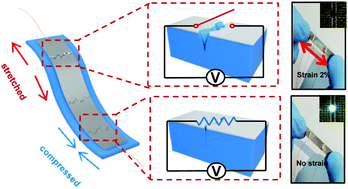Metal–elastomer bilayered switches by utilizing the superexponential behavior of crack widening†
Abstract
Strain gated switch systems have recently been developed for direct human–machine interfacing wearable electronics. These switch systems that use piezotronic nanowires or metal/elastomer bilayer films have limitations of low on–off ratios or large threshold strain. Herein, we present a metal–elastomer bilayer reversible switch system utilizing the superexponential behavior of crack widening. The crack width exhibits a superexponential dependence on the applied strain, instead of a linear dependence of regular widening. Such superexponential behavior of widening of a crack leads to an almost infinite resistance of the metal film when the applied strain approaches 2%. The resistance of the switch increases approximately by 5 orders of magnitude when 1.6% strain is applied, resulting in an overall gauge factor that exceeds 6 × 106, which shows that our device can perform as a switch. By combination of metal–elastomer bilayer strain-gated switches, we demonstrated logic elements such as AND, OR, NAND, and NOR gates by expressing the gestures of fingers as numbers on a seven-segment display. The newly proposed switch system also showed excellent durability, reproducibility, low energy consumption and tunable threshold strain.



 Please wait while we load your content...
Please wait while we load your content...